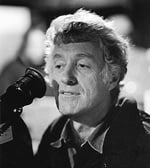[ continued from page 4 - Janusz Kaminski ]
 |
|
Courtesy of Touchstone Pictures Company |
 |
Kundun
The film presents the life of the 14th Dalai Lama in a series of lyrical, dreamlike sequences photographed with consummate skill by Roger Deakins, who combined naturalistic lighting with director Martin Scorsese's penchant for kinetic camera moves.
Martin Scorsese's Kundun is a film that truly immerses viewers in another culture. A lyrical ode to the life of the 14th Dalai Lama, the picture weaves a dreamlike spell with the help of painterly photography by renowned cinematographer Roger Deakins. "I think this film is very much a poem rather than a traditional narrative film," Deakins told AC in a comprehensive article that appeared in our February 1997 issue. "It's more of a mood piece involving a specific time and place in history, so our main challenge was to capture that feeling."
The project was a marked departure from the types of films many expect from Scorsese, whose oeuvre has often explored the violent impulses of mobsters, sociopaths and other troubled souls. The director knew that he would need a cinematographer with a fine aesthetic sensibility, and was duly impressed with Deakins, whose previous work included The Shawshank Redemption (which earned him both an ASC Award and an Academy Award nomination see AC June '95), the ASC-and Academy-nominated Fargo (AC June '97), The Hudsucker Proxy (AC April '94), Dead Man Walking, Courage Under Fire, Mountains of the Moon and Pascali's Island.
In bringing the Dalai Lama's story of personal struggle to life, Scorsese insisted upon authenticity. Determined to lend the intimate film an emotional resonance, the director and producer Barbara De Fina cast the film with native Tibetans, none of whom were professional actors. They also took the production on location to Morocco, where Deakins worked with Italian production/costume designer Dante Ferretti to craft painstakingly meticulous Tibetan tableaux. A good portion of the shoot was completed at the Atlas Film Studio in Ouarzazate, a makeshift facility that was upgraded to house the film's intricately detailed sets. Deakins says that initially, "The studio 'entrance' consisted of a mud wall with this door in the middle, and when you went through, there was one small 'stage' really just a warehouse surrounded by an expanse of desert. It was really surreal."
Once the Atlas Studio's extensive facelift was completed, Deakins installed lighting platforms and pre-rigged his major sets with an array of fixtures ordered from Cartocci in Rome. He had initially planned to leapfrog his lights from one set to another, but modified his strategy to accommodate a schedule which to some extent reflected the chronology of the script. "I didn't want to be fussing with the lights while the actors were there preparing for a scene," he explains. "On most of the sets, there were minimal lighting changes from shot to shot, because I pre-lit the sets using the platforms that had been prepped beforehand."
Deakins sought to lend the story a naturalistic look through the use of practical sources such as butter lamps. "In general, I like to make a light source look as if it's really working, instead of overpowering it with an artificial source," he says. "I do use gag lights, but I like the sources themselves to be very bright within the scene."
For exterior shots, the cinematographer notes, "We basically shot with very hot light. I suppose we made an advantage of the fact that we were shooting in the midday sun; every day was hot and bright. We really didn't shoot anything in the morning or evening; I think low, golden sunlight tends to be a bit overused. We used the bright exterior light as a nice contrast to the interiors of these monasteries, which were naturally very dark.
"Working on this show reminded me of some of the documentaries I've worked on," concludes Deakins, whose work on Kundun also earned him awards for Best Cinematography from the New York Film Critics Circle and the Boston Society of Film Critics. "It was a bit like camping: we just had to make sure we took everything we were going to need! We had a complicated schedule, difficult sets, and a remote location. But in the end, I'm very pleased with what we accomplished."
[ continued on page 6 - Dante Spinotti ]